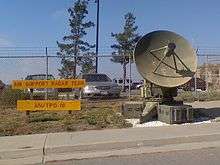GE AN/MPQ-14 Course Directing Central
| Country of origin | United States |
|---|---|
| Frequency | 2,740 to 2,960 MHz[1] |
| Range | 20,000 yd max, 500 yd min |
| Azimuth | 360° |
| Power | Peak 200 kw (83 db above 1 mw) |
The GE AN/MPQ-14 Course Directing Central was a Cold War radar/computer/communication system for ground-directed bombing (GDB) during the Korean War and was the 2nd GDB system used by the United States Marine Corps (cf. AN/TPQ-2). The combination ("Q") system provided command guidance for an aircraft to reach a predetermined release point for attacks in bad weather and nighttime, and Korea GDB operations included 900 flown by USMC Vought F4U Corsairs,[2] e.g., VMA-251 flying "...four MPQ flights for the 7th Marines in the early hours of 24 July,..." 1953.[3]
Production and deployment
The AN/MPQ-14 was created under a production contract to General Electric, and the central used the radar model from the AN/TPQ-2 Close Air Support System, a diesel generator set, AN/MRW-4 & -3 radios, and from the AN/MSQ-7 [sic]: the "guidance computer-transmitter set", data converter (spherical to rectangular computation), and "indicator-recorder" (plotting board).[1] "Housed and transported in two modified 3/4-ton trailers, two 2-1/2-ton trucks, one 3/4-ton 4x4 truck, and one mobile radar mount",[1] the USMC GDB team was ready for deployment to Korea in July 1951[4] after the USAF had begun Korean War GDB in 1950.[5] The AN/MPQ-14 was "moved into the" 1st Marine Division area[6] by the "First Marine Aircraft Wing"[4] near the 38th parallel north for guiding units such as the VMF-513 Corsair night-fighter squadron flying GDB from 15,000–20,000 feet. A variant of the central, the AN/MPQ-14A, had different radar and communication subsystems, and MPQ-14 was also produced by the "Advance"[7] and "Ultrasonic"[8] companies.
References
- 1 2 3 MIL-HDBK-162A Volume 1 Section 1. United States Army. 15 December 1965. Retrieved 2013-01-09.
- ↑ http://www.607acw.org/tadpoles.html[]
- ↑ Pat Meid; James M. Yingling (1957). The Sea Services in the Korean War, 1950–1953 (PDF). Operations in West Korea, Chapter 9. Heavy Fighting Before the Armistice, Renewal of Heavy Fighting, 24–26 July, Note 37: U.S. Naval Institute, Annapolis, Maryland. p. 1859. Retrieved 2 September 2013.
- 1 2 Merrill, Capt Grayson (undated anecdote). "Innovation Wins Wars". Your story - Class of 1934. USNA Alumni Association and Foundation. Retrieved 2013-01-07. Check date values in:
|date=(help); External link in|work=(help) - ↑ http://www.afhso.af.mil/shared/media/document/AFD-100526-023.pdf
- ↑ U.S. Marine Corps Aviation
- ↑ https://books.google.com/books?id=3WegnB4hNP8C&q=mpq-14#v=snippet&q=mpq-14&f=false
- ↑ http://radar.tpub.com/TM-11-487C-1/TM-11-487C-10403.htm
- ↑ http://research.archives.gov/description/1040918
